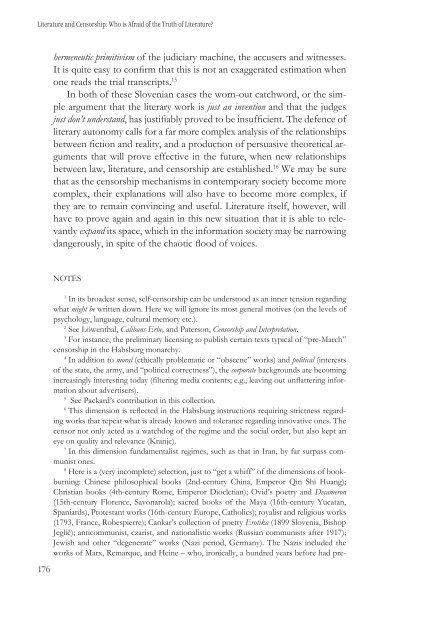Literatura in cenzura - Društvo za primerjalno književnost - ZRC SAZU
Literatura in cenzura - Društvo za primerjalno književnost - ZRC SAZU
Literatura in cenzura - Društvo za primerjalno književnost - ZRC SAZU
- No tags were found...
Create successful ePaper yourself
Turn your PDF publications into a flip-book with our unique Google optimized e-Paper software.
Literature and Censorship: Who is Afraid of the Truth of Literature?hermeneutic primitivism of the judiciary mach<strong>in</strong>e, the accusers and witnesses.It is quite easy to confirm that this is not an exaggerated estimation whenone reads the trial transcripts. 15In both of these Slovenian cases the worn-out catchword, or the simpleargument that the literary work is just an <strong>in</strong>vention and that the judgesjust don’t understand, has justifiably proved to be <strong>in</strong>sufficient. The defence ofliterary autonomy calls for a far more complex analysis of the relationshipsbetween fiction and reality, and a production of persuasive theoretical argumentsthat will prove effective <strong>in</strong> the future, when new relationshipsbetween law, literature, and censorship are established. 16 We may be surethat as the censorship mechanisms <strong>in</strong> contemporary society become morecomplex, their explanations will also have to become more complex, ifthey are to rema<strong>in</strong> conv<strong>in</strong>c<strong>in</strong>g and useful. Literature itself, however, willhave to prove aga<strong>in</strong> and aga<strong>in</strong> <strong>in</strong> this new situation that it is able to relevantlyexpand its space, which <strong>in</strong> the <strong>in</strong>formation society may be narrow<strong>in</strong>gdangerously, <strong>in</strong> spite of the chaotic flood of voices.176NOTES1In its broadest sense, self-censorship can be understood as an <strong>in</strong>ner tension regard<strong>in</strong>gwhat might be written down. Here we will ignore its most general motives (on the levels ofpsychology, language, cultural memory etc.).2See Löwenthal, Calibans Erbe, and Paterson, Censorship and Interpretation.3For <strong>in</strong>stance, the prelim<strong>in</strong>ary licens<strong>in</strong>g to publish certa<strong>in</strong> texts typical of “pre-March”censorship <strong>in</strong> the Habsburg monarchy.4In addition to moral (ethically problematic or “obscene” works) and political (<strong>in</strong>terestsof the state, the army, and “political correctness”), the corporate backgrounds are becom<strong>in</strong>g<strong>in</strong>creas<strong>in</strong>gly <strong>in</strong>terest<strong>in</strong>g today (filter<strong>in</strong>g media contents; e.g., leav<strong>in</strong>g out unflatter<strong>in</strong>g <strong>in</strong>formationabout advertisers).5See Packard’s contribution <strong>in</strong> this collection.6This dimension is reflected <strong>in</strong> the Habsburg <strong>in</strong>structions requir<strong>in</strong>g strictness regard<strong>in</strong>gworks that repeat what is already known and tolerance regard<strong>in</strong>g <strong>in</strong>novative ones. Thecensor not only acted as a watchdog of the regime and the social order, but also kept aneye on quality and relevance (Kranjc).7In this dimension fundamentalist regimes, such as that <strong>in</strong> Iran, by far surpass communistones.8Here is a (very <strong>in</strong>complete) selection, just to “get a whiff” of the dimensions of bookburn<strong>in</strong>g:Ch<strong>in</strong>ese philosophical books (2nd-century Ch<strong>in</strong>a, Emperor Q<strong>in</strong> Shi Huang);Christian books (4th-century Rome, Emperor Diocletian); Ovid’s poetry and Decameron(15th-century Florence, Savonarola); sacred books of the Maya (16th-century Yucatan,Spaniards), Protestant works (16th-century Europe, Catholics); royalist and religious works(1793, France, Robespierre); Cankar’s collection of poetry Erotika (1899 Slovenia, BishopJeglič); anticommunist, c<strong>za</strong>rist, and nationalistic works (Russian communists after 1917);Jewish and other “degenerate” works (Nazi period, Germany). The Nazis <strong>in</strong>cluded theworks of Marx, Remarque, and He<strong>in</strong>e – who, ironically, a hundred years before had pre-
















